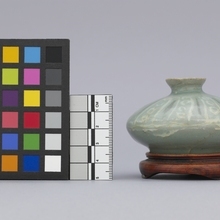Bottle
MOA: University of British Columbia
N3.97 a-b
Oil bottle (yu-byeong; 유병; 油甁). Celadon pot with vertical bands of circles separated by vertical lines. Squat, compressed spherical shape with raised neck and flared rim. Unmarked. Round wooden stand (part b) with three legs.
-
History Of Use
This small celadon yu-byeong; 유병; 油甁 (oil bottle) was used to contain hair oil or perfume during the Goryeo dynasty (918-1392). Many such objects have been found in Goryeo pit graves and stone-lined graves from the twelfth to fourteenth centuries. They are considered cosmetic utensils, since they are often excavated alongside items such as hairpins (donggot; 동곳; 銅串), bronze mirrors (donggyeong; 동경; 銅鏡), and iron scissors. While these bottles are thought to have been primarily used by women, they have also been discovered in tombs believed to belong to men. All kinds of pottery and porcelain produced during the Goryeo dynasty (고려; 高麗; 918–1392) are called Goryeo dojagi (Goryeo ware; 고려도자기; 高麗陶磁器). Celadon (green-gray glazed ceramic) known as Goryeo cheongja (고려청자; 高麗青磁) was the main kind of ceramic produced during this period in Korea. Celadon originated in China; Goryeo potters learned the techniques from the celadon traditions of the Song dynasty (960–1279). The Buan (부안군) and Gangjin (강진군) regions in Jeolla Province (전라도) became major production centres by the mid-twentieth century; Gangjin remains the centre of Goryeo cheongja revival, and modern celadon production.
-
Specific Techniques
The circled pattern and vertical lines of this bottle are decorated with an inlaid technique known as sanggam (상감; 象嵌). Believed to have been produced since the mid-twelfth century in Korea, the origin is not clear, but likely derived from the practice of decorating bronze vessels with silver inlay, or inlaid lacquerware. In the thirteenth and fourteenth centuries, this inlaid technique was widely used in the production of Goryeo celadon. The technique involved engraving patterns onto partially dried clay bodies using sharp tools, then filling the carved out areas with red or white clay, glazing them, and then firing them again. During the second firing the red clay turned black and the white clay turned white, allowing artisans to create intricate and visually stunning patterns on the surface of the celadon. The use of this technique, along with the distinctive jade colour made Goryeo celadon easily recognizable. The black and white patterns on a clear green background were the signature features of Goryeo celadon.
- Type of Item bottle
- Culture Korean
- Material clay, glaze, wood
- Manufacturing Technique thrown, glazed, inlaid
- Measurements height 6.3 cm, diameter 7.5 cm (overall)
- Previous Owner Tappit Hen Antiques
- Received from Tappit Hen Antiques, Florence Fyfe-Smith
- Made in Korea
- Creation Date between 1150 and 1392
- Ownership Date before April 29, 1969
- Acquisition Date on April 29, 1969
- Item Classes ceramics
- Condition good
- Accession Number 2248/0002 a-b


